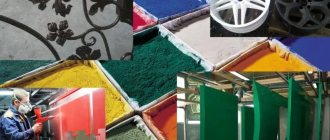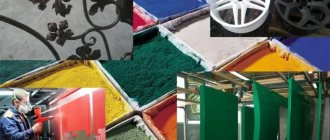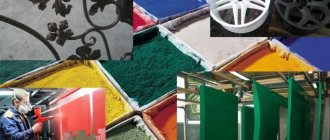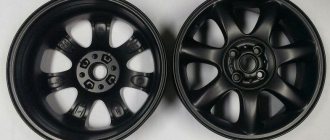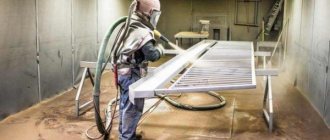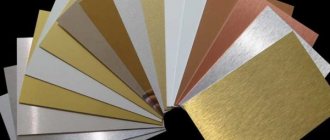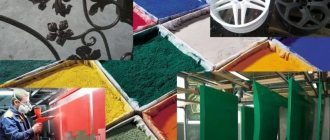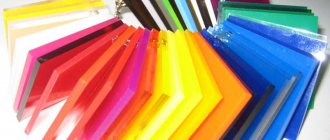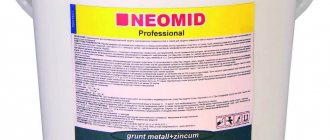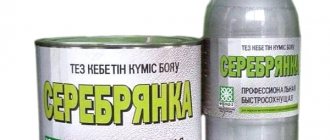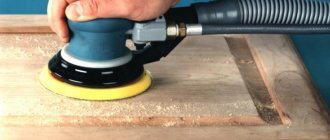Powder painting of non-metallic products
Powder paints non-metallic materials - wood, plastic, glass.
Powder painting is the application of a polymer decorative and protective coating by electrostatic spraying. Dry powder composite dyes melt and harden to create a durable paint layer.
Features of powder painting of non-metallic materials
The surface on which powder paint is applied must have three properties:
- electrical conductivity;
- high temperature resistance;
- strong adhesion (Latin adhaesio – 'sticking').
These properties are absent in wood, plastic, and glass. But modern technologies make it possible to paint non-metallic materials with electrostatic spraying. And non-metals can withstand the minimum temperature of 110-130°C required for melting/spreading of powder paint.
Technology of painting non-metals with powder: general
Common features for powder painting are low-temperature methods and basic stages of technology:
1) surface preparation (activation for electrostatic powder spraying, increasing adhesion);
2) applying paint (with a gun or in a special chamber - depends on the area to be painted);
Differences taking into account the specifics of the material:
- various activation techniques that change the properties of the surface of the material for powder spraying;
- special powder painting technology for each non-metal.
Wood powder coating technology
Powder paints are used to cover not pure wood, but products made from it. Most often - MDF panels.
- laying a layer of electrically conductive primer;
- heating MDF boards to 70-100°C.
2. Application of thermoplastic paints from a special gun using flame spraying. The powder passes through a propane flame under the action of an air stream. The melted paint forms a strong layer on the surface.
3. Melting and baking of paint powder at 120-130°C in a polymerization oven.
4. Hardening under infrared rays.
Plastic painting technology
The technique of powder painting of plastic is determined by its properties:
- low heating temperature threshold;
- low adhesion.
- applying an electrically conductive solution;
- treatment with ionized air (plasma) in an oven.
Electrostatically charged air particles charge the paint molecules. In this case, no preheating is required.
2. Spraying paint.
4. Curing the paint in an infrared oven.
Glass powder coating technology
Powder coating of glass is easier than wood and plastic.
1. Activation can be carried out in different ways:
- preheating the surface to 90-120ºС;
- applying an electrically conductive coating.
2. The method of applying the powder is determined by the activation method:
- Paints are applied to heated glass using a stream of air. Particles suspended in the air, settling on a heated surface, stick to it;
- glass with an electrically conductive coating is dipped into fluidized powder paint.
3. Polymerization in an oven.
- Hardening. The conditions for slow cooling of glass are observed due to its instability to sudden temperature changes.
Source: kaspol.ru
Chemists forum
- business newscompanies and enterprisespetrochemical companiesproductslogisticsshopping centerChemIndexscience newsjobs for chemistschemical exhibitionslaboratory equipmentchemical reagentsscience newsjobs for chemistschemical exhibitionslaboratory equipmentchemical reagentsadvanced searchresource catalogelectronic reference bookabstractschemists forumsubscriptionsurveysprojectsabout uscontacts
Powder coating MDF
Powder coating MDF
Post by MoonDog » Thu Apr 12, 2012 9:11 am
Re: Powder coating MDF
Post by Anatoly16 » Sat Apr 14, 2012 9:35 pm
Re: Powder coating MDF
Posted by Gretchen » Sat Apr 14, 2012 10:55 pm
Re: Powder coating MDF
Post by Anatoly16 » Sun Apr 15, 2012 9:27 pm
Re: Powder coating MDF
Post by MoonDog » Mon Apr 16, 2012 8:03 am
Re: Powder coating MDF
Post by novus » Mon Apr 16, 2012 9:50 am
Re: Powder coating MDF
Post by MoonDog » Mon Apr 16, 2012 10:16 am
Re: Powder coating MDF
Post by Gretchen » Mon Apr 16, 2012 4:59 pm
Re: Powder coating MDF
Posted by mcaa » Tue Apr 17, 2012 7:57 am
Re: Powder coating MDF
Post by MoonDog » Tue Apr 17, 2012 9:46 am
Re: Powder coating MDF
Post by mcaa » Tue Apr 17, 2012 10:03 am
Re: Powder coating MDF
Post by MoonDog » Tue Apr 17, 2012 11:16 am
Re: Powder coating MDF
Post by mcaa » Tue Apr 17, 2012 11:25 am
Re: Powder coating MDF
Post by MoonDog » Tue Apr 17, 2012 11:32 am
Re: Powder coating MDF
Post by Anatoly16 » Sat Apr 21, 2012 8:16 am
Re: Powder coating MDF
Post by avor » Sun Apr 22, 2012 10:01 am
Try painting with two-component thermosets. Polyesters, polyurethanes, epoxy paints.
You praise the powder so amazingly as if you are already working with it and have no problems with it, then why this topic?
Re: Powder coating MDF
Post by Gretchen » Sun Apr 22, 2012 10:17 am
Re: Powder coating MDF
Post by Smol » Sun Apr 22, 2012 12:33 pm
Re: Powder coating MDF
Post by Anatoly16 » Sun Apr 22, 2012 10:24 pm
avor wrote: Try painting with two-component thermosets. Polyesters, polyurethanes, epoxy paints.
You praise the powder so amazingly as if you are already working with it and have no problems with it, then why this topic?
MDF painting
Medium density fiberboard (MDF) has gained well-deserved popularity in the manufacture of furniture (cabinets, cabinets, shelves) and finishing elements in construction. MDF is often used as wall panels, laminate flooring or acoustic enclosures due to the good soundproofing properties that MDF has. Industrial production of this type of wood material (MDF) began in 1996 in the USA. MDF is the most modern type of wood material, meeting all the requirements of the modern construction market and furniture industry. Nowadays, the leader in production volumes is China. MDF boards have good strength, high durability at an affordable price. To improve the appearance and characteristics of MDF, painting is carried out. This type of treatment, such as painting, is necessary to protect MDF from mechanical damage and moisture absorption.
MDF is a fibrous material made by dry pressing from wood chips at high temperatures. As a result, the environmentally friendly finishing material MDF without resins and phenol comes out of the workshop, which is why we prefer it for use in children’s rooms. The gluing of wood fibers occurs due to the natural element included in their composition - lignin.
The primary process when painting MDF is enamel treatment, which is then coated with varnish.
MDF has advantages over other materials: it is easily amenable to various types of processing, milling, cutting, painting; there are no wood defects in MDF (knots, curling, rot); MDF does not deform due to changes in temperature and humidity, unlike solid wood.
Powder coating of dielectrics.
In 2008, St. Petersburg decided to develop a new technology for painting furniture facades made of MDF using powder coating plants. The existing technology of powder coating of MDF required the use of a conductive Austrian primer, which greatly increased the cost of production. A promising market, the enormous possibilities of textured powder paints (paints for “copper, bronze, granite”, “hammer enamel” and the like), the convenience of the powder technology itself painting made the task of reducing the cost of components urgent.
The task was set to replace imported components with domestic ones. As a result, the task was exceeded, because the created new powder coating technology makes it possible to successfully paint not only MDF, but also materials such as HDF, OSB, plywood, ceramics, glass, earthenware and wood, and even fabrics. In addition, the new conductive primer based on epoxy resins had increased adhesion, which ensured very high climatic resistance. Products dyed using this technology can be used outdoors, which expands markets.
6 patents were received for the new technology, two of which have already been received.
released in 2008 TU “DESCRIPTION OF TECHNOLOGY FOR POWDER COATING OF DIELECTRICS BASED ON STRENGTHENING CURRENT-CONDUCTING SOIL UTG 017“ART – ENGINEERING”
The new technology made it possible not only to gain independence from the pricing policy of the Austrian company, but also to gain many new directions in business.
- Painting a very promising environmentally friendly material OSB (wood chips pressed under very high pressure, developed in Canada, it is very difficult to paint with liquid paints),
- Painting of gypsum concrete blocks for outdoor use,
- Painting wavy and flat slate in “bronze” or “granite” colors, which increases the service life of the slate, supposedly up to 50 years,
- painting bottles and sheet glass. Many wines deteriorate when exposed to light and require the use of opaque bottles.
1. What is powder coating of MDF boards.
MDF (MDF, Medium Density Fiberboard) is currently one of the main materials used in the furniture industry and construction. Furniture facades and horizontal surfaces, overlays for metal doors, various types of finishing boards - these are far from exhausting the use of MDF and its denser and often water-resistant brother - HDF (HDF, High Density Fiberboard, high-density fiberboard). MDF production technology similar to paper production technology. The raw material used is fine wood fiber, which is pressed with an appropriate binder based on artificial resins to give it hardness and shape. Production technology also determines the main properties of MDF.
- Cheap compared to solid wood materials
- Greater uniformity compared to wood-based materials
- Ease of processing and installation
- Moisture permeability due to the porous structure (a disadvantage partially eliminated in HDF)
- Lack of natural decorative structure of surfaces (unlike wood or decorative wood-based materials)
- Release of gases similar in composition to chemical warfare agents (phosgene and the like) during strong heating
For the decorative coating of MDF, mainly two technologies are used: lamination and painting. Moreover, while the technology of painting with liquid paints is more or less traditional, painting MDF with powder paints is undergoing rapid technological development. Powder coating technology for conductive products was first used in Australia in 1967. Many publications note that the state of MDF powder coating technology is the same as metal surface powder coating technology 30 years ago. According to the figurative expression of a representative of the Nordson company, with all the technological innovations that are used in painting MDF with powder paints, these technologies still represent a high-risk area. “The market is waiting to see who will be the first to take a chance and make significant investments in the technology.”
- At the same time, everyone notes the high attractiveness of this technology. The main advantages are as follows:
- The application of powder paint is a much cleaner production in terms of the release of so-called VOCs - volatile organic substances, volatile organic compounds. These compounds are found in most liquid paint solvents.
- The powder coating process is significantly more economical in terms of powder consumption, since powder that has scattered and does not fall on the parts being painted can be collected and reused. According to Paul Peters, CEO of the Belgian company Ledro (article “Modern powder coating technology”), you can achieve:
— 99% powder recovery.
- Simple one-step paint application process
— Quick and easy color change
— When powder paints are polymerized, a number of decorative effects arise that are unattainable with conventional paints.
This article is devoted to a review of ideas, technical solutions and implemented ready-made technologies in painting MDF with powder paints.
2. MDF painting problems
When developing MDF powder coating technologies, engineers face a number of challenges. As Paul Mills put it in his article “How to Powder Coat MDF,” “It was business as usual. The small experimental parts looked great, but when the process was applied to real products, the surface was uneven, the polymerization was incomplete, and the overall quality was poor.”
The main problems can be formulated as follows:
Low conductivity MDF. The main method of applying powder paint is electrostatic. Powder paint particles become charged (either by applying an electrical potential or by friction against the spray nozzle). Charged particles “stick” to the grounded part being painted. In this case, the conductivity of this part plays a decisive role. The conductivity of MDF is significantly lower than that of metal, so the powder adheres much worse and the paint layer is thinner.
Low heat resistance of MDF. After applying the powder, further polymerization of the painted surface requires heating to a temperature of 150-200C. At these and even lower temperatures, unlike metals, MDF begins to release gases - products of decomposition of binder resins. In addition, when heated, MDF “warps” and changes shape.
Porous fibrous structure of MDF. Even high-quality MDF has a fleecy surface, which impairs the quality of the painted surface. Variation in MDF quality. Such important parameters of MDF as density and humidity vary greatly among different brands and manufacturers of MDF. Moreover, there is significant variation in parameters from batch to batch, as well as within batches. The quality of painting also depends on the conditions of preliminary storage of MDF - the material can dry out or, conversely, acquire additional moisture, which primarily affects the electrical conductivity and intensity of gas emission.
MDF painting technology
As is the case with any type of finishing, painting MDF boards begins with preparation, the surface is sanded, after which the material absorbs the paint composition to a greater extent. You can also paint the MDF surface smoothly after finishing the work.
The next stage of painting MDF boards is priming with an insulating primer and re-sanding, ensuring even greater smoothness. This is the main guarantee of high-quality further painting. Application occurs using a pneumatic sprayer. The first layer is dried for 1 hour, after which the operation is repeated.
The entire range of painting activities is carried out using a sprayer. There are two methods of painting MDF - wet and powder. The number and thickness of paint coats may vary depending on the final color and paint manufacturer.
After completing the steps described above, the MDF boards are thoroughly dried under special conditions. Its duration is usually half a day. Once dry, the MDF is stored and transported to the installation site.
The essence of the process
Powder coating is the application of a polymer layer of paint to the surface of a product, followed by sintering. Moreover, the application takes place in an electrostatic field. Thanks to this, it is possible to obtain an even distribution of the paint layer and minimize the loss of the paint itself.
Until recently, the main focus of this technology was working with metal or other conductive products, due to the nature of the technology. But for other materials there was practically no such possibility.
Matte finish technology
To obtain a matte effect on the slabs, the following sequence of operations is used:
- Sanding (P150-180) before priming
- Applying primer for insulation purposes
- Drying up to 1.5 hours
- Lint removal by sanding (P240)
- Second layer of primer (in this case polyurethane)
- Drying
- Third layer of polyurethane primer
- Drying up to 2 hours
- Sanding (P320)
- Enameling with tinted matte enamel
- Drying 4 hours
Gloss finish technology
If the customer wants to get a shine effect, then the steps are as follows:
- Sanding in the same way as for matte
- Application of an insulating primer is required to obtain a glossy effect.
- Drying and sanding (P240)
- Primer with polyester composition
- Drying up to 40 minutes
- Second layer of polyester composition
- Drying from 1 to 3 days. The duration is determined by the level of smoothness desired. An ideal surface can be obtained by drying the MDF for about a week, so that unevenness does not appear due to shrinkage. If you need to get ready-to-use sheets as quickly as possible, two days is enough.
Lacover powder paint is:
Modern production lines
FAQ _
and the answers to them
Do you have a minimum order quantity?
If Lacover powder paint is in stock, deliveries of 1 kg are possible.
Is it possible to custom order with the selection of the color we need?
Individual order is possible. When ordering over 100 kg, we select the color according to the reference color samples RAL 841-GL or customer samples.
How long does it take to produce to order?
Standard production time is up to 10 days.
What is powder paint?
Special polyester, epoxy resins and their mixtures, pigments and other special additives are mixed, melted and extruded into a thin plate, which is crushed, ground and fractionated. The result is particles of finished powder paint ranging in size from 10 to 100 microns.
How to calculate the consumption rate of powder paint per 1 m2?
The consumption of powder paint is affected by its composition, density, and recovery ability. Consumption rate per 1 m2: Shagreen - 150 - 180 g; Antique - 150 - 250 gr.; Gloss - 80 - 110 gr.
At what temperature can powder paint be stored and used?
The temperature in the room where powder paint is stored should not be lower than +5 C. When applying paint indoors, it is recommended to maintain a temperature range from +15 C to +20 C, and also maintain a relative humidity of no more than 80%.
What type of powder paint is suitable for products used outdoors?
Polyester powder paints are least susceptible to weathering.
What happens if you mix polyester and epoxy polyester paint?
Mixing these types of paint leads to the appearance of defects in the painted surface. There may be stains, craters on the coating, and a decrease in gloss. When switching from one type of paint to another, it is necessary to thoroughly clean the equipment.
What is Qualicoat?
Qualicoat (translated as quality coating) is an organization created in 1986 to carry out certifications and issue licenses for the use of the specified quality mark. The organization determines a list of requirements for the quality of coatings and production equipment to ensure a high level of product quality.
Do I need a qualified painter for powder coating?
When painting with powder, you don't need to be a professional. It is possible to obtain a uniform, high-quality coating without special qualifications.
Is it possible to sandblast a surface for powder coating?
Possible. When treated with sandblasting equipment, the adhesion of the coating improves, and rust and scale are easily removed from the metal.
How to protect certain areas of products from painting?
Places that are not to be painted are covered with paper tape and reusable silicone plugs that can withstand high temperatures.
What happens when the surface is not cleaned sufficiently?
When applying powder paint to an insufficiently cleaned surface, poor adhesion of the paint to the surface may occur; the paint may peel off and be subject to increased corrosion. During polymerization, craters and spots may form.
Why doesn't powder paint stick well to a product even though it is grounded?
Most often this happens when the suspension is uncleaned after previous staining. The resistance between the product in the chamber and the grounding bus should be no more than 4 ohms. Poor grounding leads to electric shocks, excessive paint consumption or unpainted product.
Why is a recuperator needed?
The recuperator collects and allows for reuse of powder that does not settle on the product during painting.
What mains voltage is required to operate powder coating equipment?
A voltage of 380V is used to operate the polymerization oven and powder paint spray chamber.
Which equipment to choose for applying powder paint: electrostatic or tribostatic?
Electrostatic equipment is more productive, regardless of paint type, more durable and less sensitive to moisture.
Tribostatic installations make it possible to obtain a more uniform, high-quality coating on parts of complex shapes.
How can you remove and clean the spray chamber when changing colors?
To clean the spray chambers, it is convenient to use a special industrial electric or pneumatic vacuum cleaner. An ordinary household vacuum cleaner cannot be used; it fails when paint particles get on the electric motor, where it melts and creates a layer of electrical insulation.
How to check the purity of compressed air?
It is necessary to control the purity of compressed air by periodically directing a strong jet at the paper or mirror for one minute and checking the blown surface for contamination.
Will the powder coating deteriorate if the product is bent?
Products coated with powder paint can be assembled, bent and molded without damaging the coating.
Why did the surface coated with powder paint after polymerization look like an orange peel?
It is recommended to check and adjust the paint thickness and increase the temperature in the curing oven.
What causes yellowing of a painted surface?
Obtaining a similar shade is possible at too high a temperature and a long polymerization time.
Why do surfaces painted with the same paint have different shades?
The reason may be different duration and temperature of polymerization. It is also possible that the thickness of the paint applied is different or the surface of the product is poorly prepared.
What could cause craters to appear on a painted surface?
Crater-shaped depressions are formed due to insufficient preparation and cleaning of the surface of the product. It is also necessary to check the air supply settings in the equipment.
company's news
General information about powder coatings
Industrial chemistry has developed a huge number of diverse dyes, among which powder paints easily took one of the leading positions.
Powder paint is a durable polymer coating that has anti-corrosion properties, is resistant to external environmental factors, and can also withstand chemical and mechanical influences.
The dye is made from a fine-powdered polymer into which film-forming resins, hardeners, color pigments, fillers and other additives are added.
Advantages of powder paints
Powder paints have a number of significant advantages, namely:
- High fire resistance due to the absence of solvents and catalysts when used;
- Long service life of the coating;
- Moisture resistance;
- High speed of paint hardening on the surface;
- Applying the required paint thickness the first time;
- Possibility of reusing material that has not settled on the surface to be painted;
- Easy to apply even in hard-to-reach places;
- Environmentally friendly: after drying, the paint is harmless to the environment;
- Easy to store compared to liquid paints;
- Do not require special care;
- Resistance to wide temperature ranges;
- Excellent corrosion protection;
- Good electrical insulation;
- Powder paints are available in the RAL color palette, so they easily become a means for bold design solutions. It is also possible to imitate the surface under various textures;
- You don't have to be a professional to work with powder paint.
What can you apply powder paint to?
Before you buy powder paint, you need to determine what product it will be used to cover and choose from four options:
- Polyester;
- Epoxy;
- Epoxy-polyester;
- With special effects.
Polyester paints, as a rule, are applied to outdoor objects: cars and transport equipment, billboards, playgrounds, lanterns, fences and other products exposed to active weather conditions.
Epoxy dyes have special protective properties against corrosion and chemical influences. Applied to: industrial facilities and equipment, furniture fittings, pipelines, fire extinguishers.
Epoxy-polyester paints are applied to products that are used indoors: household appliances (stoves, refrigerators, microwaves), computer cases, electronic devices.
Also, using powder paints you can achieve various effects, namely:
- aged metal effect (antique);
- imitation lizard or crocodile skin;
- metallic;
- Orange peel;
- marble and others.
Dyeing process
The paint particles are electrified, delivered to the surface to be painted, and then polymerized at a temperature of 140-200°C, resulting in the formation of a high-strength film of the required thickness. The particles are charged using a relatively easy-to-use tribostatic or electrostatic gun. Lacover powder paints - modern quality standards!
In the production of our powder paints, we use high-quality raw materials from major manufacturers and the latest equipment. In our own laboratory, we carefully check the components of future paint for compliance with quality standards, which is why you receive a product of European level.
Do you want to buy powder paint? Leave your contact information or call the numbers listed on the website, and we will select the required type of coating, as well as the desired color from the RAL K7 Classic catalog.
Why choose us?
Our company offers a full range of services related to the processing of wood fiber sheets. We carry out cutting, painting, milling, and provide assistance in the manufacture of furniture and facade elements.
We fully adhere to painting technology and ensure high performance qualities of the final material. Thus, properly processed MDF will be able to compete with natural wood. Our equipment provides painting across the entire color palette, which gives enormous scope for creativity when decorating the interior. The front side is sanded and the joints of the plates are not visible to the eye. If you need advice or help in choosing the type of slabs you need, our specialists will be happy to help.
Where is it used?
Powder paints for wooden surfaces are most often used in the manufacture of furniture. It is especially suitable for products made from MDF (medium density fibreboard). Kitchen furniture, furniture for home and office are made from MDF with this coating. From wooden parts coated with this paint and varnish material, you can make objects with curved shapes and edges without joints.
The palette of these paints is very diverse, all pigments combine well with each other. Therefore, these paints are widely used by designers when using wooden elements as decoration. Using this material, you can apply any design or inscription to MDF, obtaining an exclusive material for making furniture.
MDF painting
We carry out professional painting of MDF using modern equipment in our own painting booth, located on the territory of the main production of the Mikavol furniture factory. We invite to cooperation both private furniture makers and any companies that need to carry out painting and finishing work on this material on a regular basis.
Website of the Radalik production complex
Powder polymer painting. Painting MDF and solid wood. Manufacturing of metal products of any complexity.
- Powder polymer painting
- Painting MDF and solid wood
- Manufacturing of metal products of any complexity
There is NO quality guarantee for painting painted products (repainting).
Production of specialized furniture and production of display cases for cultural and educational institutions
For questions regarding the assortment, call: 8 or send a written request from the website.
PRICES FOR MDF PAINTING
We will paint any furniture and interior items made from MDF, in any volume and in a short time! We paint, saw, varnish, enamel and do other similar work.
We paint MDF panels, furniture parts, cornices, paint laminated MDF, interior doors, trim, baseboards, furniture facades, arches, cabinets, walls, etc.
PAINTING STRAIGHT FLAT PARTS made of MDF
| TYPE OF PAINTING | Price, rub. for 1 m2 |
| Silky matte enamel | 2500 |
| High gloss (enamel+varnish) | 5000 |
| Matte painting of the back side of the facades | 2300 |
| The reverse side of the facades is glossy (without polishing) | 4000 |
| Patina | + 1000 |
PAINTING OF MILLED AND ASSEMBLY PARTS OF MDF
| TYPE OF PAINTING | Price, rub. for 1 m2 |
| Silky matte enamel | 3000 |
| High gloss (enamel+varnish) | 6000 |
| Matte painting of the back side of the facades | 2500 |
| The reverse side of the facades is glossy (without polishing) | 4200 |
| Patina | + 1300 |
Powder painting: how it happens
To answer these questions, you need to understand the general principle of application. It involves applying coloring pigments to the surface, after which it is baked in a special oven. Melting and melting under high temperature conditions, the paint is absorbed into the surface, which ensures reliable, stable and even painting after the object has cooled.
If the very first experiments with powder coating (by the way, very successful) were carried out only under the condition of placing the object to be painted in a special oven, which significantly narrowed the possibilities of its use, today special tools have already been invented in the form of burners that allow you to “bake” the applied color powder coating.
Thus, the use of ovens is no longer a prerequisite for powder coating, but the need for a specific room remains. Powder painting cannot be done at home or on the street - even today this requires industrial workshops with appropriate equipment.
Today, more and more manufacturers are choosing powder coating. It is used in:
- production of entrance doors;
- production of glass accessories;
- automotive industry;
- furniture production;
- construction.
Can MDF be painted?
Facades, furniture panels, panels, door cladding and other products made from MDF are in great demand due to their characteristics. This is the only material among analogues that can be processed in all possible ways: milling, figured cutting, lamination, laminating, painting. Let's take a closer look at the latter.
This beautiful kitchen façade can be achieved using painted MDF
Painting MDF is a complex process and it begins with the selection of the base material – paint and varnish. If you want to get a perfectly smooth surface with a semi-matte or glossy sheen, then simple oil paint PF-115, even from an expensive foreign manufacturer, is not enough. An inexperienced master will face several problems at once:
- High absorbency of slabs, especially on sharp corners and milled bevels. The facades of furniture, doors or panels can almost completely absorb up to 5 layers of alkyd enamel. Without proper preparation, grinding and polishing, the surface will be uneven, rough, and untidy in appearance and touch.
- During transportation, the unprotected surface of MDF becomes covered with a huge number of scratches, both large and small. The paint fills them and reveals them first. Long grinding and constant monitoring will be required.
- When working, a milling tool literally tears out individual fragments, which causes small holes, dents and other defects to appear. Therefore, in addition to fine grinding, puttying with finely dispersed liquid compounds may also be required.
- Panels, doors and furniture elements made of MDF are almost always installed vertically, so drips, unevenness of the layer, etc. may occur.
- When working with a brush or roller, a large amount of so-called wood fluff rises, therefore, to obtain a smooth surface, sanding is necessary after each applied layer of paintwork.
Small roughness on the surface of MDF is the same “wood fluff”
It turns out that MDF cannot be painted? Our answer is that it is possible, but it is necessary to use a whole range of products, or, in the language of professionals, use a special program of paints and varnishes, which include:
- Several types of primer compositions: barrier primers or insulators with a pore-filling effect, elastic and easily sanded multicomponent compounds, basic pigmented compositions with a solids content of at least 50%.
- Paint with high hiding power, thixotropy, and after polymerization - wear resistance and durability.
- To create a smooth surface with a glossy/semi-matte sheen: varnish or polishing kits (paste + nap disc for polishing).
Production features of MDF surfaces
Items made from MDF and subsequently powder-painted are able to withstand all conditions to comply with the international standard DIN 68 930 for the process of painting wooden surfaces, but are not ahead of other coating methods in terms of the quality characteristics of this type of MDF.
Powder-coated wooden pieces of furniture are inferior to metal ones only in terms of chemical resistance; in all other respects, powder painting is superior to all known coating coating methods. From which it follows that any wooden furniture assembled from parts painted in a similar way meets all the criteria established by law, including those regarding furniture for children.
The approximate cost of painting MDF surfaces with powder is calculated based on the cost of powder paint per 1 square meter of MDF surface according to the method: “primer - main layer of paint” is from 2 to 3 euros, and is also determined by the color and structure of the product chosen for painting.
It would seem that with such a reasonable price for the material, the widespread use of powder coating of MDF products is suspended by the lack of necessary tools on the market for applying manual paint.
Attention! All methods of using various liquids proposed in retail sales to increase the electrical conductivity of the MDF surface with further hardening of the powder in an ordinary oven will not work. These charlatan methods were invented to deceive uninformed buyers and only discredit the very idea of powder coating of MDF products.
It is possible to carry out the procedure of powder painting on wood only with specialized equipment, in full compliance with all established technologies and subsequent control over the quality of painting in real time. Only in this way can you obtain a complete and high-quality product.
Leading manufacturing companies on the international market have long been able to adapt serial painting machines for powder coating of MDF. Catalytic furnaces were designed specifically for these purposes with preheating of product surfaces, which is mandatory before powder painting, as well as subsequent hardening of the powder after applying the paint.
Such equipment, due to its high cost, is available exclusively to large manufacturing companies with large volumes of output.
Powder painting of wooden MDF surfaces is used by both the largest international brands, for example the Vitra company (which produces luxury office furniture), and companies specializing in the sale and production of consumer goods, which can safely include the IKEA chain of stores.
Thanks to the development of a method for painting MDF surfaces with powder paint, it became possible to realize any customer’s wishes. Whether it’s painting MDF doors or a complex product shape, a regular or non-standard color palette.
Such items are widely used in creating any interior design. They have a beautiful and elegant design and are in great demand among buyers.
What paints are suitable for MDF
The easiest way to paint laminated boards. This is the surface of finished furniture and door facades, wall and ceiling panels. The film acts as a primer and leveling layer. The following types of coatings are suitable:
- Alkyd, alkyd-urethane or oil-based enamels (Novbytkhim, Dyo, Tikkurilla)
Alkyd enamels Tikkurila
These are household compositions based on synthetic oils or polymer resins. They belong to the universal category, that is, they can be used for interior and exterior work, they have good adhesion to most materials: metal, wood, glass, chipboard, MDF, OSB, etc.
After curing, a dense and durable film is formed, the advantages of which are high hiding power, resistance to mechanical and chemical influences, abrasives, and water.
Among the disadvantages, we note a strong chemical smell that negatively affects human health, as well as a huge amount of low-quality products on the shelves of stores and markets.
- Enamels based on polyurethane resins (Elakor, Ive, Teknos)
We paint correctly and according to the rules
Let's define what MDF is. This is a tile material that is made by pressing wood chips. That is, we are dealing with wood board and all the physical properties of wood.
To understand how to paint MDF, let’s determine the capabilities of the material:
- Excellent ability to withstand moisture.
- Resistance to sudden temperature changes.
- High strength indicators.
Advice! Taking into account all these parameters, it is necessary to choose a paint suitable for the material, which could change not only the external and visual indicators, but also improve the performance characteristics of the wood board.
It is the ability to withstand moisture that allows you to create excellent kitchens from painted MDF, in which air humidity can reach 80%.
It must be emphasized here that wood panels:
Painted wood panel in the kitchen takes on a whole new look
- Absolutely safe for humans, as well as for the environment, as they do not contain dangerous compounds and toxins.
- Capable of providing long-term resistance to the spread of microorganisms over the surface of the slabs.
- The same applies to the spread of fungus or mold.
- Good sound insulation.
Coloring rules
If you are wondering whether it is possible to paint MDF panels, then knowing certain nuances of the material itself, you can answer positively.
However, for proper staining, the following steps must be strictly followed:
- The surface of the panel must be completely degreased.
Advice! Today there are a huge number of different solvents that perfectly eliminate fats, but their chemical composition can have a destructive effect on the surface of the panel. Therefore, it is best to use the simplest detergents that are used in everyday life.
- Before you start applying paint, you need to treat the wood surface with an acrylic primer. This will not only ensure normal adhesion, but will also ensure that the old coating does not show through.
- Application can be carried out either with a roller, a spray gun or a simple brush.
One example of a spray gun that will be needed to apply paint
Benefits of painting
The growing popularity of painting wood chip panels has a very practical explanation. Just as fire-retardant paints for metal Polistil serve as protection for metal, certain paints and varnishes are designed to enhance the protection of the slab (read also the article “Painting MDF furniture facades”).
Therefore, we will determine the obvious advantages of applying paintwork:
- The surface under the paint layer is able to resist elevated temperatures. Nobody talks about a fire, but, for example, in the kitchen, hot utensils can often be placed on such a surface.
- Naturally, after painting, the material immediately becomes stronger, and its service life exceeds the service life of untreated slabs.
- Visually painted MDF or plastic can fit more easily into a variety of designs.
Painted wood material instantly changes the visual appearance of any kitchen
True, there is a small but significant drawback: after painting under ultraviolet rays, the paint may fade. But this does not happen immediately, but over time.
Despite the fact that panels can be painted with powder paint and enamel, polyurethane paint is most suitable for MDF, which fully meets all the requirements for the surface to be painted.
Polyurethane dye can completely change the structure of MDF externally
Preparation
You can’t just take and apply paint and varnish; the wood surface must be properly prepared.
First you need to collect the necessary materials, and these are:
- Paint, for example, is polyurethane.
- Primer. Here you can use either a wood primer or a polyurethane-based mixture.
- Varnish.
The primer can be applied to the surface with a simple brush, however, this is not the best existing option.
The preparation for coloring itself is divided into several stages, and each of them can be done with your own hands:
- The plate must be sanded. Simple fine sandpaper is also suitable for this. Sanding increases adhesion and absorption of the paint layer.
- The second step is to carry out tinting. The paint must be mixed and prepared in advance and in one color.
- A small amount of hardener is added to the primer.
Tinting will allow you to bring all the material to the same color
Once the priming composition is ready, it must be filtered. Next, it is worth noting that the primer should be applied not with a brush, but with a spray gun. No, no one prohibits working with a brush or roller, but the primer will be applied more accurately and efficiently using a pneumatic sprayer.
Advice! When choosing a sprayer, note that the size of the “gun” nozzle should be about 2 mm. The primer is sprayed under pressure of 3 atmospheres. And yet, the primer must be used within 3 hours from the moment of preparation.
The thickness of the layer will be in the range of 100-140 microns and as soon as it is applied, drying can begin. If we are talking about a polyurethane layer, then the instructions say that it will require a temperature ranging from 16 to 40 ° C. On average, it takes 5-6 hours for the layer to dry completely.
